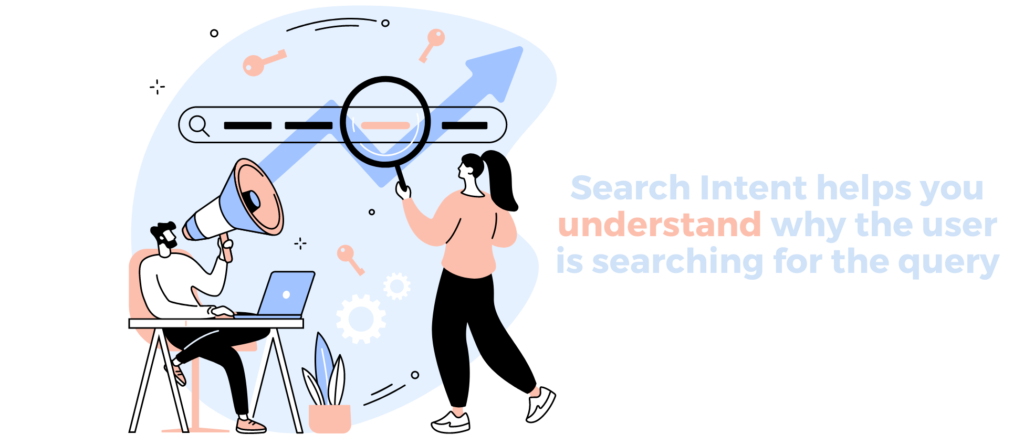
What is Search Intent SEO?
Want to tap into the mind of your customer? To really understand your target audience, you need to understand their motivation. That means understanding what brings them to your website as well as what might bring them to the competitor. Search intent refers to the reason behind the query that the searcher inputs on search engines. It represents the perspective and objective of the searcher. What are they trying to find out? What could land them on your web page?
Is it to find something? Is it to learn about something? Or is it for purchase?
Type in “Best College Recipes” into Google, and you get returned with a list of fast, effective, and easy-to-cook recipes for any beginner-level chef. This is because Google matches your intent of the search (finding information) with relevant information (recipes).
Despite its importance, search intent is used for search engine optimisation purposes and is commonly overlooked as a ranking factor.
What Are Your Potential Customers Looking For?
To attract customers, you’ve got to know what they are looking for. People aren’t coming to your website as a courtesy or because there is nothing better to read online. The visitors to your website are there because they want something. They have a problem that needs to be solved. Your ultimate mission is to solve their problem. In order to do that, you need to anticipate what exactly that problem might be.
One of the goals of search engine optimisation, or SEO as it’s commonly called, is to tap into your potential customer’s questions and needs. The foundation of successful SEO and your true objective is to understand the needs of your website reader and, finally, your customers.
Why is Search Intent Important?
- Search intent gives websites a better insight into how to optimise their website. Your web pages need to match your potential customers’ search intent. This way, Google and your organic traffic will understand the content and purpose of your website and its corresponding web pages.
Hence, the title of your pages should match your content accurately. Snippets you provide for blog articles will also have to describe the page’s content and information.
A blog article on “How to…” should be equipped with an informative step-by-step instruction or approach to the topic instead of acting as a funnel for customers to purchase.
- Search intent provides web owners with a better insight into the keywords they want to compete in or rank for. Keywords have always provided the ‘what to rank for’ element of SEO, whereas search intent is responsible for the ‘how to rank for’ aspect.
- Search intent is essential to ranking well on Google. Google’s mission is to “Organise the world’s information and make it universally accessible and useful.” Hence, in recent years of the latest decade, as Google’s algorithm and bots started to improve and change, more and more focus has been placed on matching online information to search enquiries. Effectively, this means that search intent is becoming a more critical key factor in ranking results. Google will ultimately reward pages that match search intent accurately.
- Broaden your reach across different funnel tiers with search intent. Remembering search intent allows you to create content to capture varying interest levels. From customers who are still learning about your website to those on the verge of converting, search intent, as a tool, gives you the resources you need to reach them.
How Can I Understand User Search Intent?
To get started on your mission to understand search intent, you’ll want to take out your list of potential keywords.
On top of keyword research, you can also rely on your instincts a bit here and make some educated guesses. In the case of our hypothetical company offering SEO services, you can make a few guesses off the top of your head to get started.
You might first consider the keyword “Singapore SEO services.” This is a straightforward search term for finding local companies offering the service and it’s the perfect place to start. So, you’d want to head over to Google and type in “Singapore SEO services.”
Once you have your search results, take a close look at the page. Pay attention to the paid ads as well as the organic results. Open the top results to see what kind of information these posts feature. Scroll down to the bottom to see the other related keywords (these, by the way, are great sources of information for other potential keywords).
In the case of “Singapore SEO services,” the search intent is quite clear and both customers and businesses know what they are after. In many cases, however, it is not so obvious.
How do you write a Search Intent
The kind of content you produce should be determined by search intent. Write a blog article if the keyword has an informative intent. Make a product page if the objective is to transact.
How to Optimise for Search Intent
Here are some tips on how to optimise for Search Intent:
#1 – Give the User the Information They Are Looking for
Include content about related questions that web users might be looking for. This can come in infographics, blog pages, pictures, videos, or just a list of pointers.
Make your content easy to read and digest. Aim for bite-sized content. Use headlines and subheadings to guide your reader’s attention to lengthier articles. Make the title of your page clear and concise. Engage your readers using conversational language in your writing. Remember – Write for humans, not bot algorithms.
#2 – Call to Action
A call to action is essential.
A visitor not entering your site to make a purchase does not mean they will not change their mind. Proper content is key to convincing prospects and converting them into customers.
With a clear call to action, the reader knows the next few steps to proceed with, to either make a purchase or sign up for the website. They are less likely to leave the site without accomplishing these simple 5-minute tasks.
The call to action will have to be secondary and done more subtly. Too much, and you risk scaring away your customers or annoying them with pop-up ads and massive distracting buttons.
#3 – Adapt to Changes
Search intent is like trends. They may change over time. News, current affairs, and seasonal spikes might cause a different search intent to the surface and popular search intent to die down.
Google is also struggling to improve its understanding of the true intent behind searches. Google does not share exact numbers, but as reported by SEOTribunal.com, Google handles 3.8 million searches per minute on average across the globe. Out of these millions of searches, Google reaffirms that 15% of searches are new, never-been-searched-before terms.
The sheer number of new terms makes it challenging for Google and non-human algorithms to grasp the relevant intent.
#4 – Consider Keyword Modifiers
Keyword modifiers can be helpful indicators of alternative search intent that you might not have considered. Many online tools are available for keyword research and filtering them can allow you to know which keywords rank better for each specific intent.
Related keywords can help you reach a new audience that you might not have known existed.
When Search Intent Goes Wrong
In most cases, staying on top of trends is a great strategy. Other times, however, it can be misguided. This often happens when companies try to utilise trends that are outside of the scope of their business.
An all too common mistake is to jump on the bandwagon of popular search terms. Let’s say, for example, you want to take a look at the biggest search trends of the past year. You would find that people across the globe were searching for things like “Wordle” and “World Cup.” Unless you are in the gaming app game or sports, these searches have nothing to do with your business.
Businesses unfamiliar with these searches often get drawn into the buzz and think that they can rank with these popular searches. When you understand search intent, however, you know that people searching for “Wordle” have a very low chance of wanting to buy your SEO services.
Search intent (also known as searcher intent or keyword intent) can easily get lost if you get carried away with trends so keep it simple. Stick to what you know and focus on your strengths rather than trying to be everywhere for everyone.

Types of Search Intent
Search intent is commonly divided into many categories, as searches come with varying degrees of interest and intent.
Informational Search Intent

Plenty of searches are done to attain information. This could be as basic as checking on prices or the nearest available hair salon or could be specific enough to be looking for instructions. People with informational intent usually have a question they want to find out or a particular task they require help with. This could also be triggered by viral trends or news.
Awareness of informational intent allows you to prepare your content in the right approach and direction earlier. Someone looking for ‘chicken curry recipes’ is more likely to be wanting to learn how to cook it in easy step-by-steps rather than trying to purchase a book about chickens and curry.
Why It Matters for Your Business
The vast majority of Google searches are informational. You just cannot afford to ignore them if you want visibility. Despite this, they may still present a worthwhile chance for your company to expand.
A fantastic strategy to gain your audience’s trust in your subject matter expertise is by offering them informative or instructional content. This content can be used to target fresh leads that you can later convert in addition to improving your exposure.
Navigational Search Intent

People with this level of interest are likely already invested in a specific company and are searching just to visit the company or website. However, keeping track of this intent, even if the customer is not a loyal follower of your brand, could be useful for formulating your future marketing strategies. It allows you to try to attract your competitor’s clients and convince them to choose you instead.
Why It Matters for Your Business
Navigational keywords aim to ensure that your present or potential consumers can discover you when they need you most. They are frequently branded. Additionally, they can help you understand how customers feel or behave toward your business.
For instance, if a product page consistently receives the vast majority of searches, your audience likely finds it appealing. On the other hand, if you notice a sudden increase in searches for customer service, for example, it could be worthwhile to find out why.
Tips for Navigational Intent Optimization
Organize and make it simple to traverse your website’s structure before focusing on navigational keywords. Your website should be clearly divided into sections, each with page titles, tags, headers, and descriptions that indicate the type of material that may be found there.
Ensure that every good or service you provide has its own landing page or dedicated website with the most up-to-date details. Use the right brand and product names when optimizing each page. Add additional pertinent phrases (e.g., the type of product or the problem it might solve).
Finally, make your URLs easier to understand and more descriptive.
Commercial Search Intent

Searchers under this category are looking around and shopping for information. However, unlike generic informational intent searches, investigational intent has a deeper aspect. Consumers are more likely to be making comparisons between websites and brands and looking at reviews rather than simply shopping for educational information or reading blogs.
This group of customers are more invested in the purchase, although they might not be convinced yet, and just require one last push over the fence.
Why It Matters for Your Business
Commercial keywords are all about displaying your offerings to your audience and providing them with the data they require to convert. Your audience is more inclined to proceed if they can quickly access and apply this information.
By using these phrases, you may maintain contact with your user throughout a crucial phase of their purchasing process.
How to Optimize for Commercial Intent
To target commercial keywords, similar to informational keywords, you must be aware of what the user is looking for. Then, arrange your page’s elements so that users may find the solution as quickly as feasible.
As an illustration, consider how Apple’s website contrasts the iPhone 13 and iPhone 13 Pro:
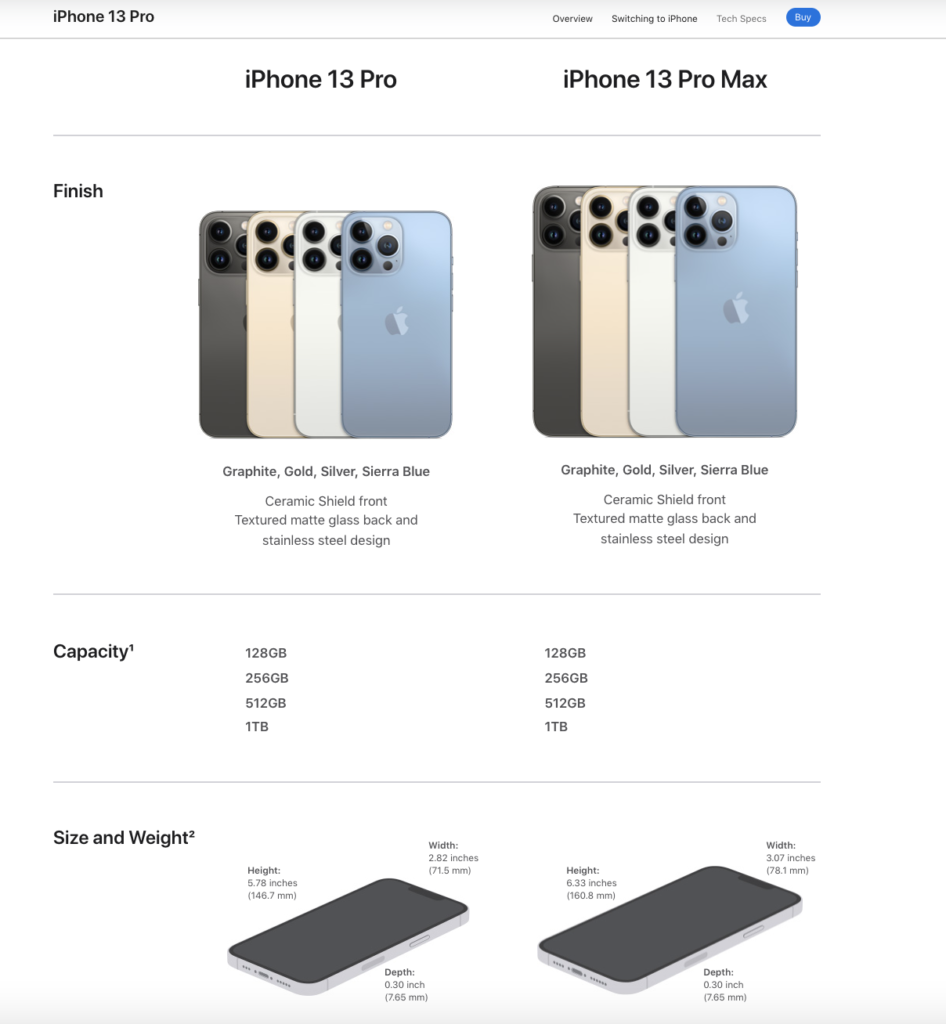
The page’s goal is to compare two comparable products. Hence it is formatted as a table with the same data on both sides and lots of pictures. Users can easily locate discrepancies or the information that matters most in this method.
Another illustration of well-organized commercial content is as follows:
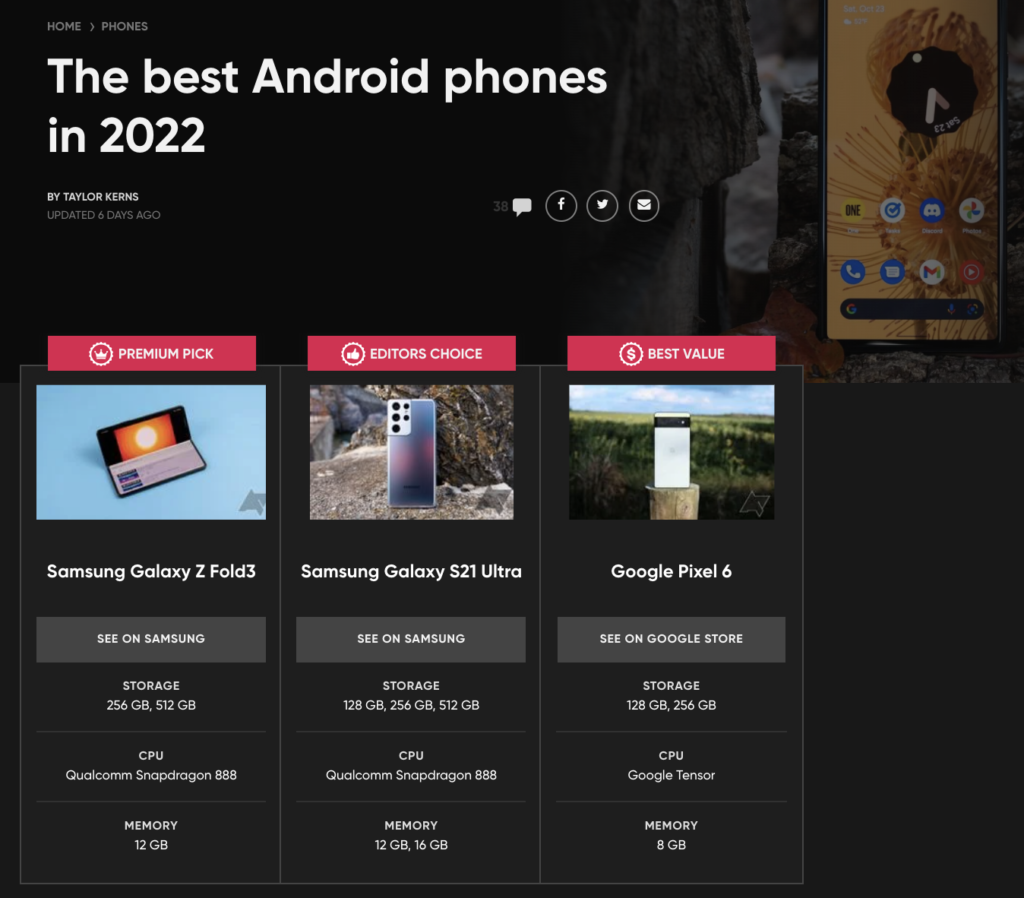
The opening paragraph of “The Best Android Phones in 2022” from Android Police provides a brief summary of their findings. Their top three images are also shown in a table so visitors may quickly compare pertinent data.
The article goes on to give each phone its own header:
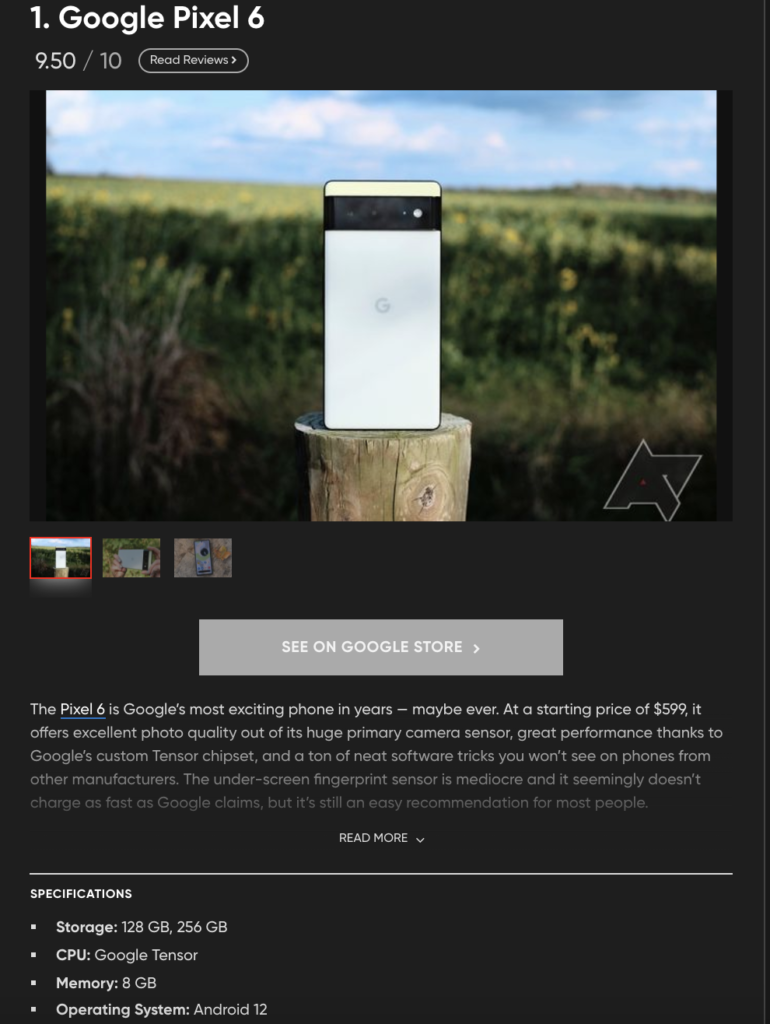
Take note of how the most crucial information is highlighted. The technical specifications and other information come after the name of the phone, the rating, and a link to reviews. If readers wish to know more about the editors’ reasoning, they can also expand.
The commercial content in both cases (Apple and Android Police) was well-structured, well-organized, and reader-friendly. Users might make a smooth buying decision after immediately educating themselves.
Apply a similar mindset to your website’s commercial material. First, consider: What is it that my audience is looking for on this page? Create a page that is well-structured after keeping that demand in mind.
Next, add keyword-rich page titles, headers, meta descriptions, and URLs to optimize it.
Lastly, provide links to additional information, lead generation forms, or purchase pages to make it as simple as possible for customers to make a purchase.
Transactional Search Intent

Usually accompanied by long-tail keywords and voice searches, transactional intent represents a customer’s intent to make a purchase or employ a service. Most of the time, customers at this stage are already ready to purchase, and conversation rates are noticeably higher. This category of intent represents the highest convertible tier of customers and has been the focus of marketing campaigns due to its high intent keywords.
Why It Matters for Your Business
Your revenue generators are transactional keywords. Whatever conversion means to you, these are the terms that your potential consumers will employ when they’re ready to buy.
Target transactional keywords with an optimized product landing page and a simple checkout process to take advantage of your opportunities.
How to Target Transactional Keywords
Targeting transactional keywords entails: • Understanding the meaning of conversion for you (Do you want them to register? Purchase something?”
• Including all pertinent data in the most user-friendly format possible.
• Simplifying the converting process as much as you can
Whether consumers arrive at your website from Google or another source, you want this process to be easy. To do this, make sure all pertinent pages are simple to locate and have all data required for users to carry out the intended action.
First, confirm that you’re sending visitors to a page created specifically for this function, whether it’s a landing page or a product page. The following elements should be present on this page:
- Your keywords in the Page Title, Description, and Headers; and
- A clear CTA that is simple for users to see and understand
- A clear design that makes it simple for users to find the information they require and complete their conversions
- Conversion-optimized text that streamlines the decision-making process by conveying the most important details in an interesting manner
Last but not least, take advantage of structured data to improve Google’s comprehension of the content on the page so that it can present it to users when they are ready to convert. This technical SEO tutorial has more information on the use of structured data.
What Are High Intent Keywords?
High intent keywords are closely related to high intent searches. They work similarly by showing a deeper interest on the consumer’s part. Much like voice searches show a greater level of purchase intent, long-tail keywords are signs of a different tier of web users that deserve a closer look from companies.
How to Determine Search Intent
Search intent is usually evident from the wording of the search terms themselves. Most search terms use verbs, which clearly show the customer’s intent to purchase, discover or be interested.
Nevertheless, there are a few tips on the writing prompts that can be used to kickstart your content marketing efforts to match search intent:
- Informational Intent
- Guides, How-To,
- Where/Why/Who to Find,
- Tutorials and Resources
- Downloadable Content
- Examples, Tips, Tricks, Ideas
- Navigational
- Brand names
- Name of a product/company/website
- Feature articles
- Commercial Intent
- Comparison articles/videos
- Reviews
- Size/Colour/Value-for-money analysis
- Top 10 lists
- Transactional
- Coupon/Vouchers/Discounts
- Bulk purchase offers
- Pricing guides
Performing keyword research using tools like Ahref’s Keywords Explorer can allow you to filter for your keywords with specific intent. Modifiers and filters may not be perfect, but they would help sift through tens of thousands of search terms to give you a more refined understanding of your customer base.
Keyword modifiers help search intent indicators. It is not sufficient to know the keywords, but finding these terms also matters. Keyword tools can help to filter words, including phrases or modifiers. You can filter the keywords using the SERP feature.
SERP research is another way to determine search intent. Type the target keyword and see what SERPs turn up on Google. You can identify what Google deems relevant search intent for every term from the results.
Let’s understand SERP results for every intent type
For informational intent
Informational keywords ranking for related questions, knowledge panels, and featured snippets. The top results include an informative blog post, Wikipedia, or Dictionary.
For commercial/preferential research intent
A featured snippet will show in the preferential research intent results but can even include PPC on top of organic results. It will offer details about brands searched instead of topic information.
For transactional intent
Usually, transactional SERPs lead with PPC and shopping reviews, carousels, and shopping results. Organic results show product pages from offline and online retailers; depending on the search, it can include a location map.
For navigational intent
The users already know where they want to go. They are looking for the most relevant page on top. If the search term used is Amazon, then the top result will be Amazon’s homepage.
Consider the entire picture
Remember, a term can have multiple search intents. Therefore, looking at a single keyword or SERP is hardly enough to define search intent. Take a holistic approach to get closer to the critical search intent. SERPs are volatile; therefore, a specific keyword that ranks top this month might not rank high the next month.

What Are Product Or Service Keywords?
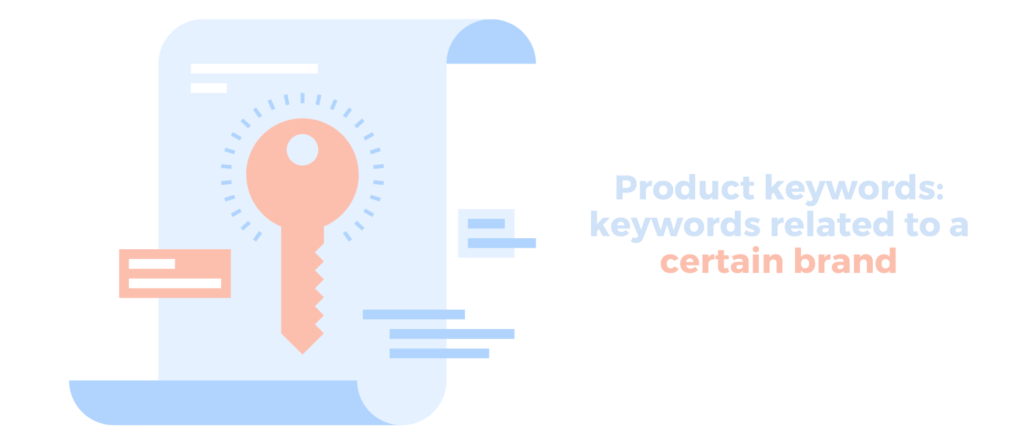
Product-defining keywords are terms related to a specific brand or product. These keywords are phrases that directly name or reference a company’s products or services, similar to branded keywords.
Examples include ‘Nike Tennis Shoes’ or ‘Ridge Minimalistic Wallet’. These keywords would be commonly used in other commercial or marketing platforms to prompt web users to search for these terms.
Companies should have a keyword strategy for each of their products (or services). This can allow prospective customers to land on the product pages more efficiently.
Brands should have a keyword strategy for each product and service so customers and prospects can find their offerings through search.
Service keywords work the same, but for services instead.
Both aspects signify a group of commercial-driven keywords.
Which Search Intent Should You Optimise For?
While it may be tempting to target transactional intent as they seem more likely to be converted into leads, the answer is rarely that straightforward. Ultimately, it depends on the marketing goals and strategies.
Do you want to build your customer base?
Do you want the current marketing campaign to boost your sales?
Do you want to test your content marketing strategy?
Do you want to stand apart from your competition?
While lower-interest search intents may not immediately lead to sales, they can create an opportunity for your brand and website to grow. Over time, more visitors may be slowly guided through your sales funnel, from brand awareness to product purchase.
It is also important to note that sole focusing your efforts on transactional search intent may fall short, as it might signify only a small portion of your current viewers. This is exceptionally true for smaller and newer websites.
How to Optimise Search Intent?
So, how do you find out more about search intent?
- Examine the search results page. The search results in the ranking page (SERP) give us more direction in understanding search intent. Google already understands what people want to see when they are searching. Search results like ‘name card holder’ or ‘minimalistic wallet’ have a high commercial search intent, evident from the search results showing more product pages rather than information or images.
One of the many SERP features of Google is the featured snippet section, commonly used to push e-commerce shopping options, video results and related answers. Google tends to show snippets for more frequently searched terms.
Different snippets are also featured depending on the search intent. For example, searching for information on a topic nets you an information snippet from Google in response to your query. However, searching with transactional intent, with “Buy the latest iPhone model” ends you up with a carousel of purchasing options from Google. - Use Google Ads to help determine the scope of Commercial Intent. In Google Ads, the suggested bid and competition are reflected by the commercial intent behind the keywords. While companies may not be ready to commit to pay-per-click ads (PPC) yet, it is still helpful to know what your competitors are willing to pay for advertisements in your industry.
- Analysis of your existing content. Understanding if your content marketing strategy is meeting the needs and demands of your visitors is more important than constantly churning new content to facilitate conversations. You can save both time and money by tweaking existing content. High bounce rates from search engine referrals may indicate poorly optimised and mismatched content. A lower click-through rate is a similar symptom. The issue may be that the keywords you are ranked for are unsuitable for your content.
4. Maximise your site’s user experience. In addition to matching the intent of your web visitors, you need to provide a pleasant web-surfing experience for your prospects. This includes changing your site to guide your users better and cutting down on the aspects that might score or chase them away.
- Limit popups. Google doesn’t like popups, and the same can be said for many other people.
- Proper navigation. Let Google and your visitors understand your site’s infrastructure and layout better.
- Proper subheadings. Google wants their answer fast. To achieve that, they skim your content for the headers and subheadings. Having keywords in these areas can help optimise your site better.
- Use videos and infographics. Videos offer a more passive approach to feeding the user information. The user has to sit back and listen instead of actively reading and digesting information. Infographics represent an effective way of providing easy-to-digest information.
5. Ask your customers. Do a small survey containing questions on how your customers manage to find your website, what they are searching for, and what they were looking for, but you do not have. Offer incentives in exchange for answers to gain valuable insights into your audience.
6. Measure your results and adjust. Like other digital marketing campaigns, optimising search intent requires effort and time. Trial and error and research cumulate into learning processes that can be used to refine your approach.
7. Match content type and metadata to the intent
After comprehensive keyword research and planning on which ones to target with which web pages, it is time for optimisation. The first step towards SEO is with Metadata. Update the title tag [H1 & H2] with a specific primary keyword. Try to leverage the title tag with a compelling copy to enhance the click-through rate [CTC].
8. Examine the competition
It is logical to overcome the current top competitors. So, perform a competitor analysis on the top-ranking pages to find out how their webpage is formatted, their strong points, which points are covered if there is a content gap, and more. The answers to these questions will help to create relevant content.
9. Categorise content ideas based on search intent
Before performing a comprehensive keyword, a research map can categorise content ideas based on search intent. It helps to visualise content distribution properly. If you are creating informational content, there are great ways to drive traffic, but it can take time for them to transform into paid customers.
Therefore, you must create commercial intent-driven content to support the sales team. It gives a broad outlook and a place to define other aspects like formats and keywords.
10. Passive intent optimization
Active intent is explicit in a query. For example, a seeker looks for ‘choosing a reliable driving school’. You created a page and offered details on determining a suitable professional, followed by what your driving school service provides.
It is even if the seeker used a search query as to how to choose a reliable driving school, after which the seeker will want to join a driving school. Here the user has a passive intention, so you added more contexts to the page.
While creating optimized content for search intent.
- Gain familiarity with search intent before content optimisation.
- Use SERPs to define content possibilities and optimal formatting.
- When you discover new terms, then use special modifiers in keyword research.
- Offer valuable, unique, and high-quality content all the time.
How to Understand Search Intent: The Complete Checklist
Ready to optimise your website? Here is a quick to-do list with everything that you need to do to tap into your potential customer’s search intent.
- Research search trends that are relevant to your business
- Inform customers in the Informational Search Intent phase
- Connect with customers in the Navigational Search Intent phase
- Optimise your landing page for Commercial Search Intent phase customers
- Optimise your products and services page for Transactional Search Intent
Conclusion
Search intent explains the reason behind searches. People enter a search engine with either an objective or question in mind. The goal of websites is to appear in front of these users with a friendly and informative display of information.
As Google shifts its attention to the user’s experience, search results that can provide the searcher with the best information stand to win the SERP ranking game.
Focusing on the information and questions attached to the keywords is an important marketing strategy that sets it apart from more dated approaches.
Updating your content and landing pages to be geared toward search intent is more important than blindly integrating keywords into your website.
If you need assistance with digital marketing, explore the top digital marketing agencies in Singapore!
Start Optimising for Your Customer’s Search Intent Today
Keep up the digital rat race by applying the latest SEO knowledge and content marketing strategies.
Leading Solution is a reputable digital marketing agency in Singapore. Talk to us regarding your digital marketing needs today.
We provide digital marketing services such as:



